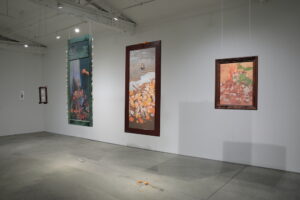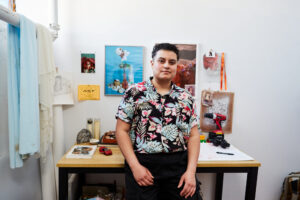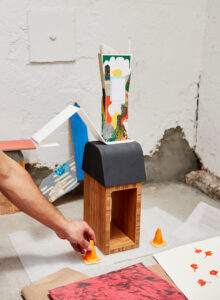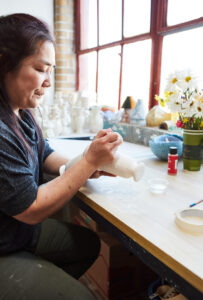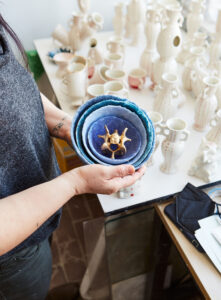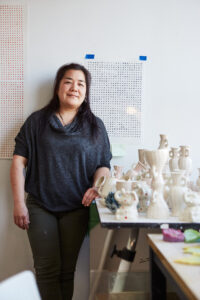Blog
Meet the Curator: Caroline Wright discusses “Mira, Miru,” the 2022 VisArts Resident Artist Exhibition
Caroline Wright is the consulting curator behind the Visual Arts Center of Richmond’s resident exhibition, “Mira, Miru.” Caroline is no stranger to VisArts — she worked as Director of Exhibition Programming at the Visual Arts Center of Richmond from 2011-2016. In this role, she curated contemporary art exhibitions in an extensive range of media and styles, working with emerging and established artists to create site-specific installations of new work. Caroline earned an MA in modern and contemporary art from the University of Virginia and a BA in studio art, art history and journalism from Washington and Lee University. Her work in art education includes jobs in museums, non-profit galleries, high schools, colleges, and universities.
Before moving to Richmond, Caroline worked at the National Gallery of Art and Monticello, and she served as a Governor-appointed member of the North Carolina State Art Society Board of the North Carolina Museum of Art. In 2017, Caroline founded Caroline Wright Art Advisory. Caroline’s advisory services are informed and inspired by her foundation in curatorial practice and education and her career-long experience and joy of working with artists and arts professionals.
In this brief interview with Caroline, she shares her experience working with the resident artists Amarise Carreras, Eric Rivera Barbeito and Sayaka Suzuki to help curate Mira, Miru. Their 2022 Resident Exhibition explores the artists’ cultural identities and histories from both personal and globally focused perspectives.
- Mira, Miru
- Amarise Carreras, Courtesy of Alexis Courtney Photos
- Artist in Residence 2022
VisArts: What does “Mira, Miru” mean? And how did that title for the exhibition come about?
Caroline: The words “mira” and “miru” translate “to look” in Spanish and Japanese. We had a group discussion about the exhibition title, and in that discussion, we agreed to gather words and phrases relevant to each artist’s individual practice. Eric suggested these two words, as his and Amarise’s first language is Spanish and Sayaka’s is Japanese. The rhythm and the visual and audible connections felt just right.
VisArts: What’s the best way for viewers to experience some of the works exhibited in the gallery?
Caroline: The works in “Mira, Miru” are meditative and encourage historical reflection. Each artist has a performative aspect to their work, so I encourage discovering the remnants of performance in each room. Several of Sayaka’s pieces are interactive, inviting the viewer to write something, take a selfie, or even join her for tea at designated times. At the entrance, hand-held gallery maps guide you through the works and offer statements from each artist that aid in understanding their installations.
- Eric Riviera Barbeito, Courtesy of Alexis Courtney Photos
- Artist in Residence 2022
- Artist in Residence 2022
VisArts: Were there any challenges in putting together this exhibition?
Caroline: All calendars and programming have been affected by Covid over the past two years. This exhibition was no exception—the show dates were moved a few months. It’s customary for the residents’ exhibition to open at the culmination of the residency, but in this case, the exhibition opened a few months earlier than expected. So these three artists present work made in just six months, mostly using materials each had never explored before. It’s an incredible testament to their collective efforts and full-force immersion into the studios at VisArts
- Sayaka Suzuki, Courtesy of Alexis Courtney Photos
- Artist in Residence 2022
- Artist in Residence 2022
VisArts: As someone who is familiar with the studio program here at VisArts, what are your thoughts about the growing residency program here?
Caroline: This exhibition speaks volumes to the importance of the residency program at VisArts and to the staff’s outstanding selection of artists. This residency maximizes the extremely unique combination of remarkable opportunities and spaces VisArts has to offer: incredible working studios and individual studios, a stunning exhibition space and public exhibition opportunity, funding for artist stipends, and staff to support artists’ needs for creative exploration. This residency will most certainly shape the direction of these artists’ respective careers going forward, and I think their work here underscores why this program should continue to grow and receive support from our community and beyond.
The Visual Arts Center of Richmond’s Annual Artist Residency is an 11-month program that invites three emerging visual artists and one creative writer to use resources available at VisArts to develop their creative practices, explore various media and make new work. The Annual Artist Residency is funded in part by the National Endowment for the Arts, the Windgate Foundation, CultureWorks, Virginia Commission for the Arts, and the Allen and Margot Blank Foundation.
